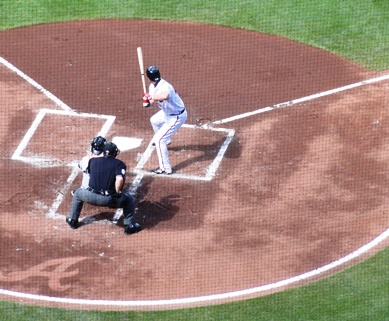Sports
Baseball Gameplay
Back to Sports
Back to Baseball
Baseball Rules Player
Positions Baseball
Strategy Baseball
Glossary
 Photo by Ducksters
Photo by Ducksters
The rules of baseball can be quite complex. They can be divided up into four sections: 1) the playing field 2) game structure 3) pitching and hitting 4) getting an out.
Baseball Playing Field
The playing field in baseball is made of an infield and an outfield. The infield is defined by 4 bases that form a square. This square is called the baseball diamond. The bases are called home plate (this is where the batter stands), first base, second base, and third base. The runners advance to each base in order. In the middle of the infield is the pitcher mound. The pitcher must have one foot on the pitcher rubber when throwing a pitch. In a standard baseball field the distance between each base is 90 feet. The distance from the pitchers mound to home plate is 60 feet and 6 inches. The lines that are formed between home plate and first base as well as home plate and third base are the foul lines. These lines extend out to the outfield and, together with the home run fence, define baseball's outfield.
Baseball Game Structure
A baseball game is defined by outs and innings. A game is usually made up of 9 innings, but may be less innings at many levels of play. During each inning each baseball team gets a turn at bat. The home team bats at the bottom of the inning. During a teams turn at bat they get to keep batting as long as they don't have three outs. Upon getting a third out, either the inning is over or the other team takes their turn. The winner of the baseball game is the team with the most runs at the end of the final inning. A run is scored for each player who safely crosses home plate. If the game is tied another inning is played until there is a winner.
Baseball Pitching and Hitting
Each "at bat" in a game starts with a pitch. The pitcher throws the ball over home plate in an effort to get a strike. A strike is when the baseball is pitched over the area of home plate, above the batter's knees, and below the batter's belt. This "strike zone", however, is up to the interpretation of the umpire calling the game. A strike also takes place when the batter swings at the baseball and misses it entirely, regardless of the location of the pitch. A strike also is called when a batter hits the ball foul. A foul ball only counts as a first or second strike. Any fouls after the second strike, do not count as balls or strikes. A pitch that is not a strike and is not swung at by the batter is called a ball. If the pitcher throws 4 balls, the batter gets to advance to first base. This is called a walk. If the pitcher throws 3 strikes, the batter is out.
If the batter hits the baseball within the field of play, he then tries to advance on the bases.
Getting an Out
Once the batter hits the baseball in play, the batter becomes a base runner. The defensive team, or fielders, try to get the base runner out before he/she can get to the safety of a base. The first goal is to catch the baseball before it hits the ground. If the fielders do this, the batter is out and all other base runners must return to their original base before they are tagged, or they will be out. Once the ball touches the ground in play, then the fielders must get the baseball and try to tag base runners or "force" them out. A force out is when the base runner has nowhere else to go but to the next base. This is always the case with the batter and first base. In the case of a force out, the defenders do not have to tag the runner, but just have a foot on the base and control of the ball prior to the base runner touching the base.
To tag a runner out, the defensive player must tag the runner with the baseball or with the glove that is holding the baseball.
An out can be achieved at any time there is a base runner. If a base runner tries to steal a base or has a big lead off of the base, the pitcher or catcher may be able to throw them out. In this case, they need to tag the runner.
More Baseball Links: